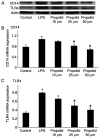Post-treatment with propofol inhibits inflammatory response in LPS-induced alveolar type II epithelial cells
- PMID: 35261621
- PMCID: PMC8855515
- DOI: 10.3892/etm.2022.11174
Post-treatment with propofol inhibits inflammatory response in LPS-induced alveolar type II epithelial cells
Abstract
Over-inflammation and severe lung injury are major causes of morbidity and mortality in patients with coronavirus disease 2019 (COVID-19). With the COVID-19 pandemic, an increasing number of patients with preexisting lung injury and inflammation are undergoing surgery or artificial ventilation under sedation in intensive care units, where 2,6-diisopropylphenol (propofol) is a commonly used drug for sedation. The aim of the present study was to investigate whether post-inflammation treatment with propofol protects epithelial type II cells against inflammation in an in vitro model of inflammation. The A549 cell line, characterised as epithelial type II cells, were exposed to lipopolysaccharide (LPS) for 2 h and subsequently treated with different concentrations of propofol (0, 10, 25 or 50 µM) for 3 h. Western blot and reverse transcription-quantitative PCR analyses were used to detect the protein and mRNA expression levels, respectively, of CD14 and Toll-like receptor 4 (TLR4). Immunofluorescence staining was used to detect the in situ CD14 and TLR4 expression in epithelial type II cells. Tumor necrosis factor (TNF)-α production was also examined using ELISA. LPS significantly increased the expression of CD14 and TLR4, as well as the secretion of TNF-α. Post-treatment with 25 and 50 µM propofol of the LPS-treated cells significantly decreased CD14 and TLR4 expression, as well as TNF-α secretion, compared with the cells treated with LPS only, indicating that post-treatment with propofol alleviated inflammation and this effect was dose-dependent. The present study suggested that treatment with propofol after LPS administration has a protective effect on epithelial type II cells.
Keywords: CD14; Toll-like receptor 4; epithelial type II cell; lipopolysaccharides; propofol.
Copyright: © Yang et al.
Conflict of interest statement
The authors declare that they have no competing interests.
Figures



References
LinkOut - more resources
Full Text Sources
Research Materials
